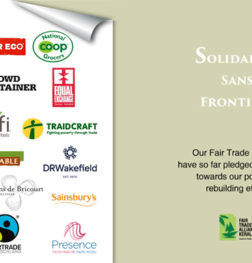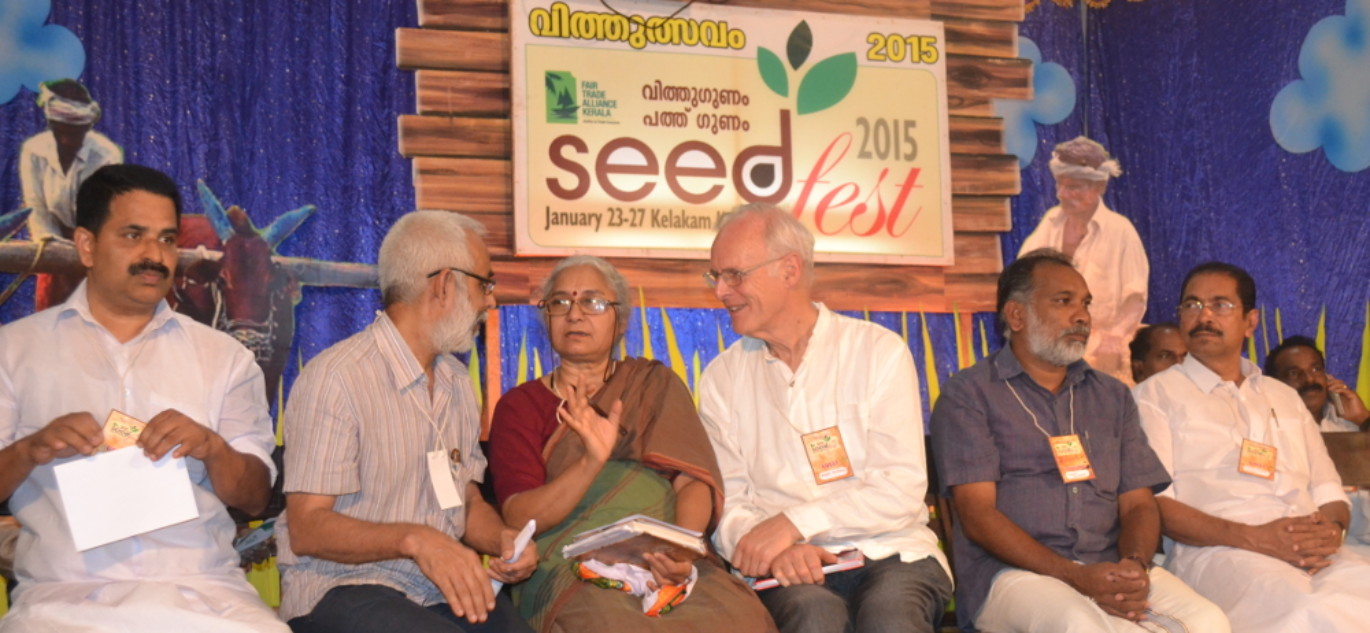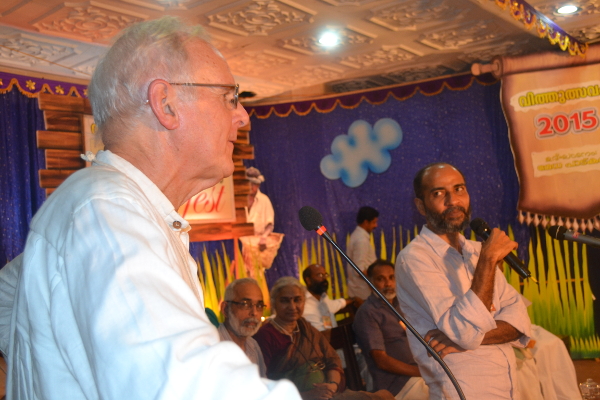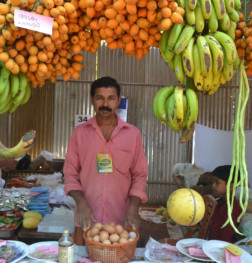
Reflections on the Seed festival
29 June 2017
(Robin Murray reminisces about SeedFest 2015 which he visited with his wife Frances. Robin and Frances dug in to scarce personal savings to make the trip to bear witness first hand to what he termed as a precious creation.)
I last came to Kelakem1 in September 2008 for the first annual meeting of Liberation Nuts. That week was decisive in finding a course for our new company to successfully ride out the financial tsunami that followed the collapse of Lehman Brothers only the week before All those who were there – the other nut producers from Malawi, Mozambique, Bolivia, Peru, El Salvador, and those selling the nuts in Britain and other Northern countries – can never forget the wonderful welcome we received from FTAK’s2 farmers and their families at this moment of crisis. Nor the lectures, the dances, the sharing of ideas between fellow farmers across continents, and of course the Kerala curries.
And so when FTAK invited my wife Frances and me to come as guests to the Seed Festival it was the greatest pleasure to return to Kelakem and witness how FTAK has itself grown in depth and richness as well as numbers over those seven years, to visit the new coconut oil factory, the schools and the farms, and then the Festival itself.
To put it in a nutshell, the Festival is a precious creation. I’m not surprised that it is inspiring other regions in India to hold their own festivals for it is at the very heart of the struggle between a sustainable food system centred on the work and knowledge of small farmers, and an unsustainable industrialised food system dominated by a handful of multinational corporations.
The threat that this industrial food system poses to India was a revelation to us. Neither of us who had grown up in the 1950s on small farms, Frances in Uruguay, and me on the English border with Scotland had realised how significant was the battle over seeds. We’d read about it, but not lived it. Our farms reared stock – beef cows and sheep, as well as some chickens and a few pigs. Since then industrial farming has Henry Ford’s principles of mass production plus genetic manipulation to all these animals. Quality has been sacrificed to quantity. They have been drivers of the move to GM feed crops. Their wastes have polluted ground water that has now spread all the way to the oceans. The intolerable stress on the animals themselves has led to widespread use of anti-biotics that have entered the food chain.

Our visit left us with the strong impression that these same industrial principles provide an even greater threat to the centuries old farming ecology of India. The talks at the Festival brought home the consequences of applying the primary condition of industrial food crop production – namely standardisation and predictability – of soils, of seeds, of water, and of farming methods. This has meant the use of artificial fertilisers to counter soil diversity; the construction of dams to feed mass farming’s hunger for water; the use of pesticides to offset the loss of natural ecological balance; and a catastrophic loss of diversity of crops. It substitutes the narrow science of the laboratory for the traditional knowledge of the farmer. And threatens the autonomy of hundreds of millions small farmers with the monopoly of a few multinationals. We have since learned the same 6 multinationals alone control 60% of the world market for fertilisers, pesticides and seeds.
One talk after another at the Festival gave witness to the side effects that the policy architects of this industrial crop production didn’t predict – such as the soil degradation, or the return of pesticide resistant pests and herbicide resistant weeds. Nor did the architects appear to give any weight to the devastating consequences of the dams, the climate change impact of such a carbon intensive food system, or the loss of indigenous knowledge and destruction of communities. It seems as if the scorpion of progress is stinging its own head.
That is the dark side. But the Festival pointed towards such a different future. The farms we visited came over as wonderful examples of agro-ecology in practice and we gathered were typical of FTAK farming traditions more generally. The plants and the trees (even the weeds) were grown to complement each other. They hosted good insects to control the bad. They provided fodder for the cows, and food for the family. Each farmer came over as his or her own expert, at what suited their particular soil and their micro climate. They seemed to be constantly experimenting. It is no wonder that Gandhi said that every village was its own research lab.
What was so striking was the extraordinary diversity. On one two acre plot we counted well over 100 different trees and shrubs. In a sample of 12 stalls at the Festival we counted over 2,000 different plants and seeds. On the Thanima Women’s stand3 there were 190 different kinds of rice (they told us that the seeds for 28,000 varieties of rice have still survived in India, each suited to its own soil and climate). In the cattle pens there were 13 different breeds of traditional cows.
All this richness is entirely lost in the standardisation of industrial farming which can only think in silos: a single crop, (or a single breed) and the quantity it can produce. Not what it needs to sustain production in the long term. It thinks of farming and the soil not as an organic system but as a machine, with the mind set of an engineer, and the possessiveness of a private accumulator.
The FTAK farmers and their families could not have been more different in their spirit of co-operation on which, in evolutionary terms, all successful living systems depend. . No outsider could fail to have been struck by the generosity which everyone displayed to each other and to us as visitors.
Frances’ nephew Sacha is a practitioner of Chinese medicine in Peru and had asked us to look out for white turmeric which is not grown in his country. Thomas Mellam Thadathil from Wayanad spent a whole morning with Frances describing the different turmerics and how they should be grown. And at the end he insisted on giving abundant samples of each to send to Sacha, saying he was sure that at some point one of Peru’s indigenous plants would find its way back on a return journey. Thomas’ gift has had hair raising adventures through Peruvian customs and laboratories but with luck will soon successfully take root in its new home.
So the SEED festival gave us a front row view of what a sustainable 21st agriculture could be like. And there are many grounds for hope that it can prevail. This kind of agro-ecology is spreading rapidly in Latin America. The Via Campesina movement of nearly a billion small farmers has become an international voice for ecological farming. It is at the heart of the fair trade movement. The consumer food movement in the West is pushing back against industrial food, and developing new ways of growing, distributing and cooking food within cities. The wonderful food plots we saw in the schools around Kelakem, are appearing in some schools in England, along with a movement to have organic school meals prepared on site (rather in some great central industrial kitchens).
What is thought of as traditional can in the information age become the new modern. In many industries the computer revolution has allowed small producers to challenge the large multinational giants, by working collaboratively. The same can happen in farming. On one of our farm visits the farmers son (who had his own plot) said he was hoping to train in computers, but also loved farming. There were other families where some of the sons and daughters had left the farms to work in electronics, said they wanted to return. Could this younger generation find ways of contributing their new knowledge to the resilience of sustainable agriculture? Is there scope for FTAK to set up a laboratory of its own to supports its members?
Seeds like knowledge have their own way of spreading. Some by the air. Some by birds. Some by their slow expansion underground. Frances and I returned home with the seeds of our experience as your guests at the Festival. In the spirit of Thomas from Wayanad we will do our best to spread them further among our colleagues in Britain and beyond.
Robin Murray
1 Kelakam town, fast growing, beautiful, serene place in the Kannur district of Kerala.
2 Fair Trade Alliance Kerala. Elements is the sole marketing partner of FTAK.
3 Thanima is a women’s group from Pulpally town, Wayanad district of Kerala.



Insightful. thanks